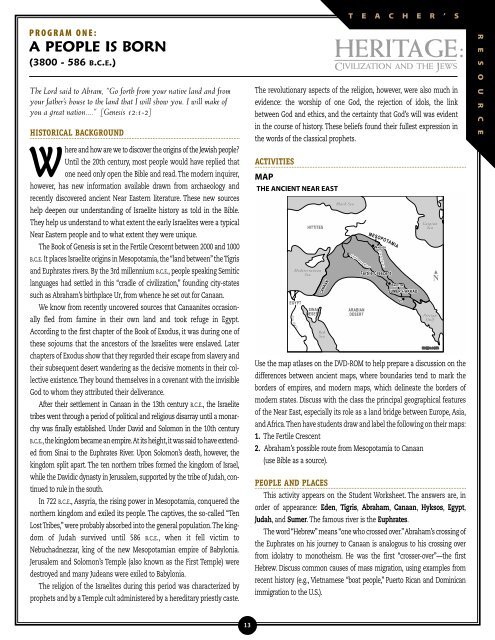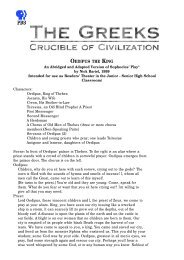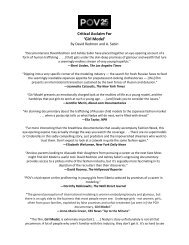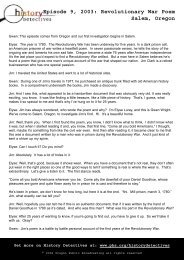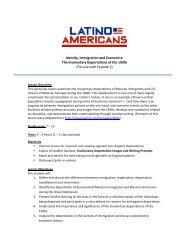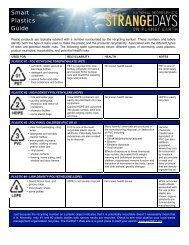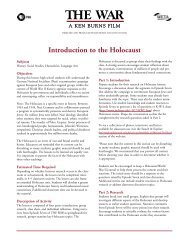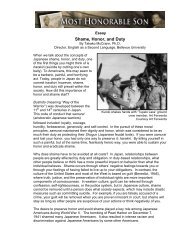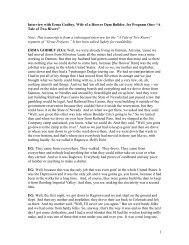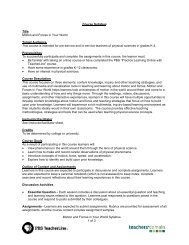HERITAGE: Civilization and the jews - PBS
HERITAGE: Civilization and the jews - PBS
HERITAGE: Civilization and the jews - PBS
You also want an ePaper? Increase the reach of your titles
YUMPU automatically turns print PDFs into web optimized ePapers that Google loves.
PROGRAM ONE:<br />
A PEOPLE IS BORN<br />
(3800 - 586 B.C.E.)<br />
The Lord said to Abram, “Go forth from your native l<strong>and</strong> <strong>and</strong> from<br />
your fa<strong>the</strong>r’s house to <strong>the</strong> l<strong>and</strong> that I will show you. I will make of<br />
you a great nation....” [Genesis 12:1-2]<br />
HISTORICAL BACKGROUND<br />
Where <strong>and</strong> how are we to discover <strong>the</strong> origins of <strong>the</strong> Jewish people<br />
Until <strong>the</strong> 20th century, most people would have replied that<br />
one need only open <strong>the</strong> Bible <strong>and</strong> read. The modern inquirer,<br />
however, has new information available drawn from archaeology <strong>and</strong><br />
recently discovered ancient Near Eastern literature. These new sources<br />
help deepen our underst<strong>and</strong>ing of Israelite history as told in <strong>the</strong> Bible.<br />
They help us underst<strong>and</strong> to what extent <strong>the</strong> early Israelites were a typical<br />
Near Eastern people <strong>and</strong> to what extent <strong>the</strong>y were unique.<br />
The Book of Genesis is set in <strong>the</strong> Fertile Crescent between 2000 <strong>and</strong> 1000<br />
B.C.E. It places Israelite origins in Mesopotamia, <strong>the</strong> “l<strong>and</strong> between” <strong>the</strong> Tigris<br />
<strong>and</strong> Euphrates rivers. By <strong>the</strong> 3rd millennium B.C.E., people speaking Semitic<br />
languages had settled in this “cradle of civilization,” founding city-states<br />
such as Abraham’s birthplace Ur, from whence he set out for Canaan.<br />
We know from recently uncovered sources that Canaanites occasionally<br />
fled from famine in <strong>the</strong>ir own l<strong>and</strong> <strong>and</strong> took refuge in Egypt.<br />
According to <strong>the</strong> first chapter of <strong>the</strong> Book of Exodus, it was during one of<br />
<strong>the</strong>se sojourns that <strong>the</strong> ancestors of <strong>the</strong> Israelites were enslaved. Later<br />
chapters of Exodus show that <strong>the</strong>y regarded <strong>the</strong>ir escape from slavery <strong>and</strong><br />
<strong>the</strong>ir subsequent desert w<strong>and</strong>ering as <strong>the</strong> decisive moments in <strong>the</strong>ir collective<br />
existence. They bound <strong>the</strong>mselves in a covenant with <strong>the</strong> invisible<br />
God to whom <strong>the</strong>y attributed <strong>the</strong>ir deliverance.<br />
After <strong>the</strong>ir settlement in Canaan in <strong>the</strong> 13th century B.C.E., <strong>the</strong> Israelite<br />
tribes went through a period of political <strong>and</strong> religious disarray until a monarchy<br />
was finally established. Under David <strong>and</strong> Solomon in <strong>the</strong> 10th century<br />
B.C.E., <strong>the</strong> kingdom became an empire.At its height, it was said to have extended<br />
from Sinai to <strong>the</strong> Euphrates River. Upon Solomon’s death, however, <strong>the</strong><br />
kingdom split apart. The ten nor<strong>the</strong>rn tribes formed <strong>the</strong> kingdom of Israel,<br />
while <strong>the</strong> Davidic dynasty in Jerusalem, supported by <strong>the</strong> tribe of Judah, continued<br />
to rule in <strong>the</strong> south.<br />
In 722 B.C.E., Assyria, <strong>the</strong> rising power in Mesopotamia, conquered <strong>the</strong><br />
nor<strong>the</strong>rn kingdom <strong>and</strong> exiled its people. The captives, <strong>the</strong> so-called “Ten<br />
Lost Tribes,” were probably absorbed into <strong>the</strong> general population.The kingdom<br />
of Judah survived until 586 B.C.E., when it fell victim to<br />
Nebuchadnezzar, king of <strong>the</strong> new Mesopotamian empire of Babylonia.<br />
Jerusalem <strong>and</strong> Solomon’s Temple (also known as <strong>the</strong> First Temple) were<br />
destroyed <strong>and</strong> many Judeans were exiled to Babylonia.<br />
The religion of <strong>the</strong> Israelites during this period was characterized by<br />
prophets <strong>and</strong> by a Temple cult administered by a hereditary priestly caste.<br />
The revolutionary aspects of <strong>the</strong> religion, however, were also much in<br />
evidence: <strong>the</strong> worship of one God, <strong>the</strong> rejection of idols, <strong>the</strong> link<br />
between God <strong>and</strong> ethics, <strong>and</strong> <strong>the</strong> certainty that God’s will was evident<br />
in <strong>the</strong> course of history. These beliefs found <strong>the</strong>ir fullest expression in<br />
<strong>the</strong> words of <strong>the</strong> classical prophets.<br />
ACTIVITIES<br />
MAP<br />
THE ANCIENT NEAR EAST<br />
T E A C H E R ’ S<br />
<strong>HERITAGE</strong>:<br />
CIVILIZATION AND THE JEWS<br />
Use <strong>the</strong> map atlases on <strong>the</strong> DVD-ROM to help prepare a discussion on <strong>the</strong><br />
differences between ancient maps, where boundaries tend to mark <strong>the</strong><br />
borders of empires, <strong>and</strong> modern maps, which delineate <strong>the</strong> borders of<br />
modern states. Discuss with <strong>the</strong> class <strong>the</strong> principal geographical features<br />
of <strong>the</strong> Near East, especially its role as a l<strong>and</strong> bridge between Europe, Asia,<br />
<strong>and</strong> Africa.Then have students draw <strong>and</strong> label <strong>the</strong> following on <strong>the</strong>ir maps:<br />
1. The Fertile Crescent<br />
2. Abraham’s possible route from Mesopotamia to Canaan<br />
(use Bible as a source).<br />
PEOPLE AND PLACES<br />
This activity appears on <strong>the</strong> Student Worksheet. The answers are, in<br />
order of appearance: Eden, Tigris, Abraham, Canaan, Hyksos, Egypt,<br />
Judah, <strong>and</strong> Sumer. The famous river is <strong>the</strong> Euphrates.<br />
The word “Hebrew” means “one who crossed over.”Abraham’s crossing of<br />
<strong>the</strong> Euphrates on his journey to Canaan is analogous to his crossing over<br />
from idolatry to mono<strong>the</strong>ism. He was <strong>the</strong> first “crosser-over”—<strong>the</strong> first<br />
Hebrew. Discuss common causes of mass migration, using examples from<br />
recent history (e.g., Vietnamese “boat people,” Puerto Rican <strong>and</strong> Dominican<br />
immigration to <strong>the</strong> U.S.).<br />
R E S O U R C E<br />
13


